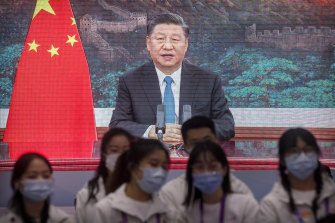The world is watching as China’s Delta outbreak hits an already vulnerable economy
For our free coronavirus pandemic coverage, learn more here.
The Delta variant of the coronavirus has dashed hopes of a smooth recovery in global growth with China, first in and first out of the plunge in economic growth last year, now facing new threats as outbreaks of the virus hit an economy with pre-existing challenges.
There has been a new wave of infections across China since last month’s outbreak in Nanjing – they are now at seven-month highs – which the authorities have responded to with lockdowns, travel restrictions and limits on entertainment and large gatherings.
China’s tough approach to the pandemic and the impact it will have on activity means the new outbreak will have some dampening effects on growth and not just within China but within its major trading partners’ economies and the already-disrupted global supply chains that connect China’s economy with the rest of the world.Credit:AP
A number of conferences and other major events have been cancelled – the 2021 Beijing Cyber Security Conference (for which tens of thousands of attendees were expected) and the annual World 5G Conference among them – as the authorities roll out the draconian playbook they so successfully used to get last year’s outbreak under control.
That would inevitably have had an impact on economic growth that had been rebounding strongly.
In the first quarter of this year China’s GDP grew 18.3 per cent (a rate somewhat exaggerated by its comparison with the worst of the pandemic effects last year) before slowing to a still very strong 7.9 per cent in the June quarter.
The economy had been expected to grow at a rate just below 7 per cent in the third quarter and for something close to 9 per cent for the full year. Now forecasts are being cut quite sharply to reflect an expectation that full-year growth will be closer to 8 per cent than 9 per cent, after third quarter growth of less than three per cent.
It’s not just Delta, although China’s tough approach to the pandemic and the impact it will have on activity means the new outbreak will have some dampening effects on growth and not just within China but within its major trading partners’ economies and the already-disrupted global supply chains that connect China’s economy with the rest of the world.
China, pre-pandemic, was focused on reducing the leverage and risks within its economy – continuing legacies of its response to the 2008 financial crisis – and trying to shift its balance away from a reliance on exports to a greater contribution from domestic consumption.
It was forced by the pandemic to reverse course, using fiscal and monetary stimulus to blunt the worst impacts of the pandemic.
As the economy roared back in the second half of last year on the back of extraordinary global demand for its medical equipment and supplies and, subsequently, consumer goods it refocused on domestic risks.
Its debt-to-GDP ratio had blown out from 255 per cent in 2019 to about 280 per cent, which probably significantly understates the ratio, given that China’s local governments are masters at raising “hidden” off-budget debt.
The initial waves of the pandemic, coupled with the continuing after-effects of the trade and sanctions wars between the US and China and the additional layers the Biden administration has added to both, caused enormous and continuing disruption to global supply chains. The shortage of semiconductors, in particular, is disrupting production of complex manufactures, most notably (but far from exclusively) automobiles.
China’s economic rebound faces a big challenge as it deals with a Delta outbreak.Credit:Bloomberg
As the world’s key manufacturing base, that has had particularly significant impacts on China.
The boom in demand for consumer goods, and China’s own stimulus measures, also sparked a boom in demand for raw materials.
Commodity prices – like oil and gas, coal and iron ore – have rocketed. It hasn’t helped China’s manufacturers that its ban on Australian coal, coinciding with efforts to reduce China’s carbon intensity, has helped drive up the cost of energy.
Factory-gate inflation has been surging – it rose 9 per cent last month – and is feeding into higher core inflation more broadly despite the authorities’ efforts to dampen the commodity price rises with its threats of action against hoarding and speculation and its releases of commodities from its strategic reserves.
That will impact the profitability and stability of China’s industrial sector even as the authorities’ extraordinary assault on the big end of their tech sector disrupts, destabilises and destroys wealth in the fastest-growing segment of the economy.
The combination of slowing growth, rising inflation and corporate and market instability isn’t a good one in an economy over-laden with debt and with some of its vast state-owned and private conglomerates, like Huarong and China Evergrande, teetering under the weight of their own debts and questionable assets.
When the People’s Bank of China cut bank reserve requirements in July – before the Delta mutation emerged in China, or at least was visible outside China – it raised eyebrows given the rate of growth then occurring within the economy. Injecting liquidity into its banking system is usually China’s first response to financial or economic threats.
The obvious conclusion was that either the efforts to crack down on excessive leverage might be having some adverse consequences or the economy was slowing more significantly than the authorities were comfortable with, or both. With hindsight, the Delta outbreak could have been the other key motivation.
Just as there is no likelihood that a post-pandemic future will resemble its pre-pandemic condition anytime soon, economies are going to be continually disrupted to various degrees – as Australians can attest – by the evolving course of the pandemic.
It is likely the authorities will relegate leverage and inflation to second-order issues as they respond to the slowdown in the economy. Social stability has always been their priority.
More cuts to the reserve requirements and interest rates and, perhaps, some targeted fiscal stimulus may be on their agenda for the rest of this year as they try to put a floor under the economy that enables them to deliver the 6 per cent-plus GDP growth rate they have been targeting for the post-pandemic environment.
While some of China’s challenges are peculiar to China (because, despite its growth, it is still in a developing phase and because of the levels of state intervention and control) the impact of mutations of the coronavirus is one that every economy is going to have to deal with for the foreseeable future.
Just as there is no likelihood that a post-pandemic future will resemble its pre-pandemic condition anytime soon, economies are going to be continually disrupted to various degrees – as Australians can attest – by the evolving course of the pandemic.
China has been prepared to implement measures that most western nations wouldn’t contemplate to get the coronavirus under control and its government plays a far larger and more central role in its economy than is the case in the West.
How the world’s second-largest economy and Australia’s major trading partner fares in dealing with the Delta outbreak and the threat to its people, growth and stability may be of, not just great interest, but real consequence for the rest of us.
The Market Recap newsletter is a wrap of the day’s trading. Get it each weekday afternoon.
Most Viewed in Business
From our partners
Source: Read Full Article




